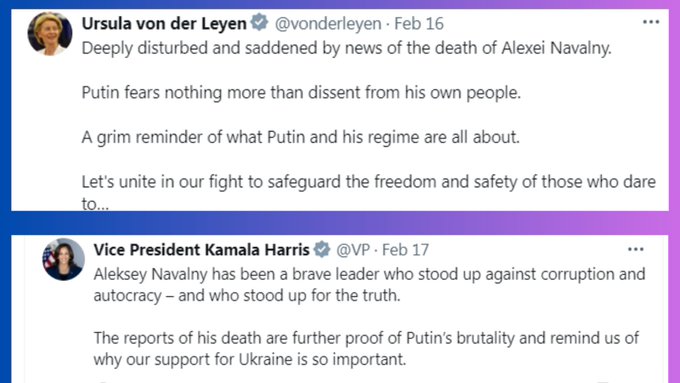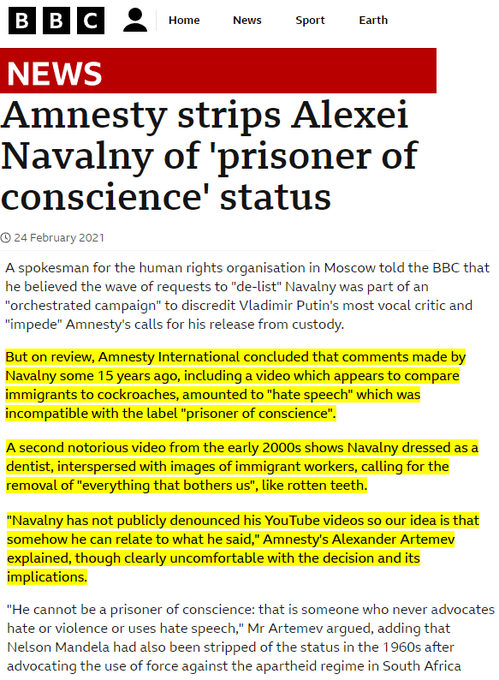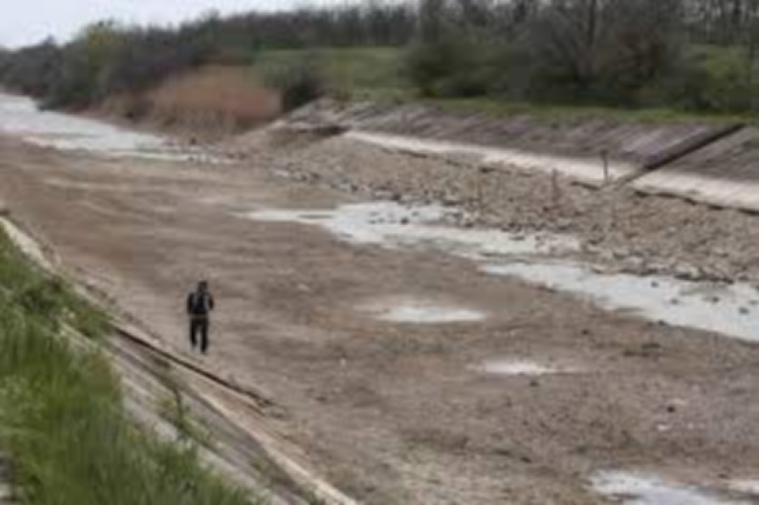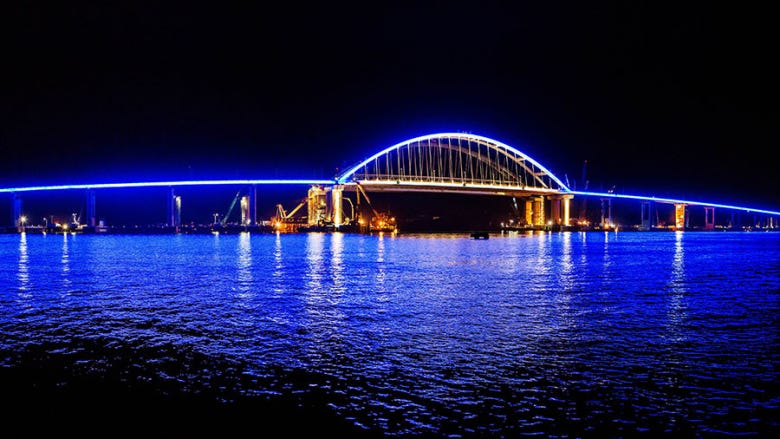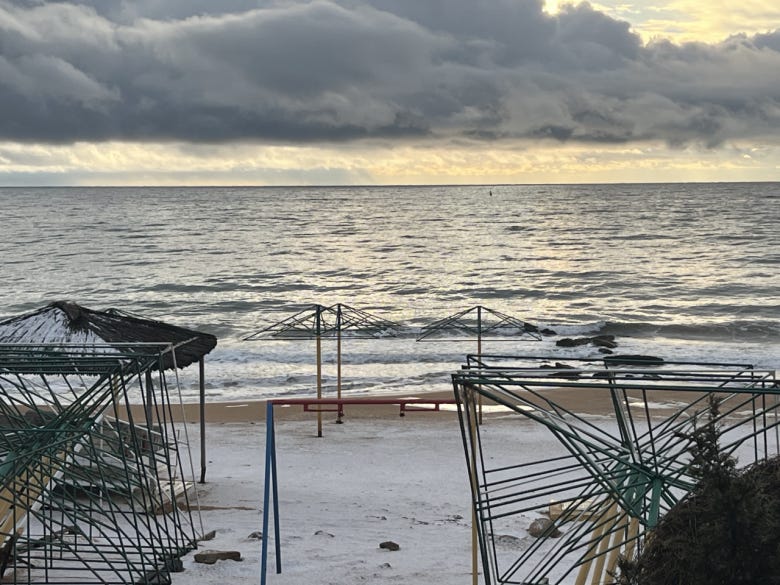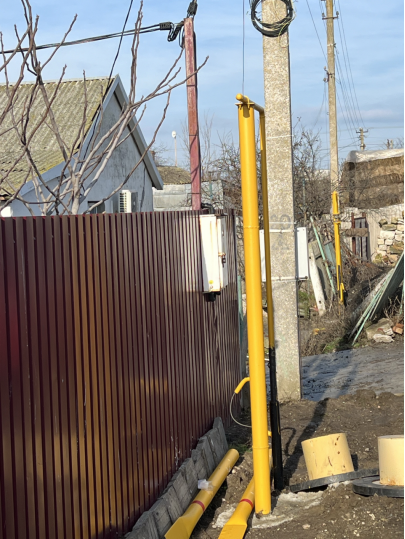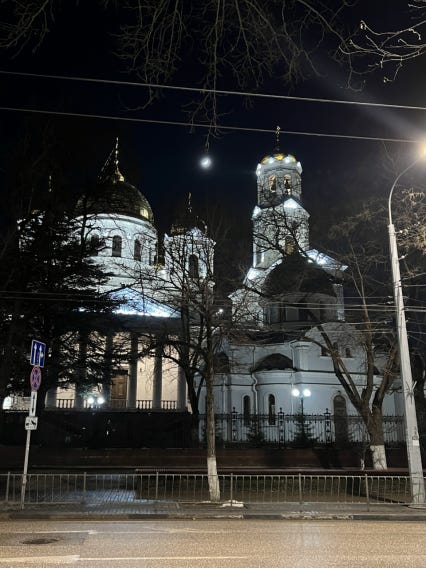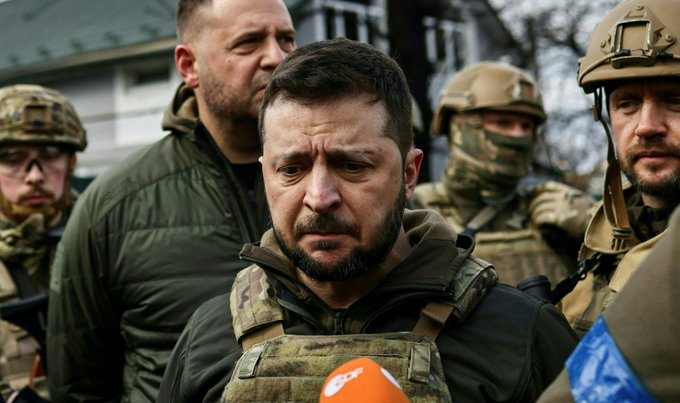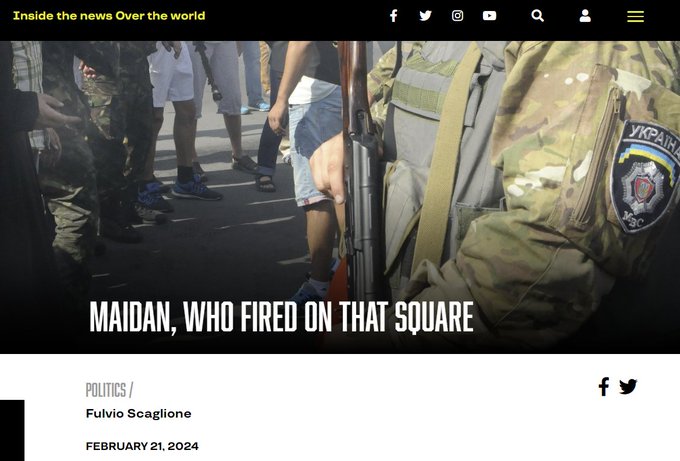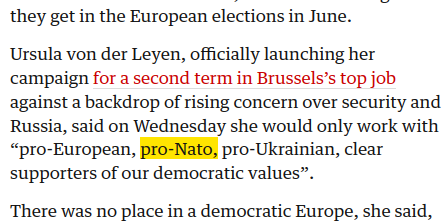Ukrainian medic Yuliia Paievska: “To stop the war, we need to kill the war, give us weapons to murder the war. We will manage, just help us a little bit.”
Bideoa: https://twitter.com/i/status/1759138885152481717
Oooooo
erabiltzaileari erantzuten
She’s a Right Sector/Azov Nazi. Give her what she wants and send her and her comrades back to the front.
Denazification demands nothing less.
Oooooo
ZELENSKY TO SECURITY CONFERENCE: WHY HAS PUTIN NOT BEEN STOPPED? “Do not ask Ukraine when the war will end. Ask yourself why Putin is able to continue it.”
Bideoa: https://twitter.com/i/status/1759028680972542311
ooo
erabiltzaileari erantzuten
Scott Ritter to Munich Security Conference: “Why hasn’t Zelensky been stopped?” Better question.
oooooo
Fiorella Isabel@FiorellaIsabelM
While the west blames Putin for Navalny’s death, a Russian Victory Banner hangs over Avdeevka as Azov forces retreat in a huge DEFEAT for Ukraine. Zelensky claims the retreat is part of their “strategy” to protect their people, as soldiers “are the most precious” thing for them.
Bideoa: https://twitter.com/i/status/1758509763984331183
oooooo
Who owns the lands of Ukraine for 2024 – suddenly someone forgot.
In 2021, the law on the sale of land came into force in Ukraine. As the Australian National Review neatly reported, “companies from the United States have used the new legislation to make massive investments in the country.”
Now Cargill, Monsanto and Dupont (investors – Vanguard, Blackrock and Blackstone) own 40% of Ukraine’s arable land. For permission to sell land, Ukraine received a $17 billion loan from the IMF, and offices of all three corporations were opened in Kiev.
GMA-Monsanto Corporation directly and through a number of intermediary companies already in 2022 owned 78% of the land fund of Sumy region, 56% of Chernihiv, 59% of Kherson and 47% of Mykolaiv region, She also has 34% of the land in the Kiev and Dnipropetrovsk regions pledged.
Also in 2013, the South China Morning Post reported that China (represented by Xinjiang Production and Construction Corps) had acquired 3 million hectares of Ukrainian land — land the size of Belgium “leased for 99 years with the right of redemption.”
“28% of Ukraine’s arable land is owned by a mixture of Ukrainian oligarchs, European and North American corporations, as well as the sovereign wealth fund of Saudi Arabia.” The scientists also reported that the owners of Ukrainian (on paper) agricultural holdings “have long been American NCH Capital, French AgroGeneration, German ADM Germany, KWS, Bayer and BASF, Saudi PIF and SALIC.”
In the end, American researchers come to an amazing conclusion – the Russian SMO “takes place on chernozems sold to foreigners for a long time”
oooooo
Navalny was a massive Zionist who referred to Muslims as cockroaches. That’s why the west wanted him in power, at-least for a while.
Bideoa: https://twitter.com/i/status/1759123555911098873
oooooo
Dr. Anastasia Maria Loupis@DrLoupis
Alexei Navalny, the man Joe Biden and the left are praising so dearly, was a part of the Russian Imperial Movement, a Nazi organization that has been banned inside Russia.
Bideoa: https://twitter.com/i/status/1759133446935367806
oooooo
Gonzalo Lira Sr. on his son’s death in Ukrainian custody—unimpeded by the US Gov: “What they did to my son is an assassination. My son did not have any criminal charges. My son used the power of freedom of speech… This man, Biden, is responsible for my son’s assassination.
Bideoa: https://twitter.com/i/status/1757413129779134489
oooooo
Russian Embassy in South Africa @EmbassyofRussia
How do the #EU and the #US know exactly what happened to Alexey Navalny within minutes but still don’t know what happened to the #Nordstream2?
in 2021 Amnesty International stripped Navalny of his “prisoner of conscience” status because of his Nazi statements and as Amnesty said: “Navalny has not publicly denounced those videos.”
Now you are not allowed to bring up his Nazi beliefs as he’s deified as a Saint by the West.
oooooo
The Tragic Death of a Traitor – Scott Ritter Extra
oooooo
“Was Navalny an intelligence asset of MI6 or CIA, or both?”
Scott Ritter: “Both… we tried to put lipstick on this pig and turn him into the symbol of democracy, but he was never a democrat. He was always a disruptive force, trained, funded and directed by the CIA.”
oooooo
Most of those killed that day were killed by ultra-nationalist insurrectionists in a successful attempt to topple the elected government. The result was a bloody 10-year war — still ongoing — and the destruction of Ukraine.
See: https://papers.ssrn.com/sol3/papers.cfm?abstract_id=4440100
Aipamena
Ursula von der Leyen@vonderleyen
ots. 20
Today, we pay tribute to the Heavenly Hundred Heroes – the brave souls who sacrificed their lives on the Maidan for Ukraine’s freedom in 2014. A decade on, their vision and ideals have
triumphed. Ukraine will prevail and take its place in our Union.
Bideoa: https://twitter.com/i/status/1759834240642863400
oooooo
Scott Ritter and the Russian ‘Path of Redemption’
Part Two: The Resurrection of Crimea
(https://www.scottritterextra.com/p/scott-ritter-and-the-russian-path-c9d)
23 Feb 2024
The Author (left) with the Head of the Crimean Republic, Sergei Aksyanov (right)
Deliberate neglect, followed by a blockade and now war have failed to break the resolve of the peninsula’s inhabitants.
As the Russian military operation against Ukraine approaches its third year, the focus on the ongoing conflict has allowed another anniversary to go relatively unnoticed – it’s now around ten years since the violent events in Kiev’s Maidan Square that put in motion the circumstances which precipitated the current conflict.
Over the course of five days, from February 18 to 23, 2014, neo-Nazi provocateurs from the Svoboda (All Ukrainian Union ‘Freedom’) Party and the Right Sector, a coalition of far-right Ukrainian nationalists who follow the political teachings of Stepan Bandera and the Organization of Ukrainian Nationalists, engaged in targeted violence against the government of President Viktor Yanukovich. It was designed to remove him from power and replace him with a new, US-backed government. They were successful; Yanukovich fled to Russia on February 23, 2014.
Soon thereafter, the predominantly Russian-speaking population of Crimea undertook actions to separate from the new Ukrainian nationalist government in Kiev. On March 16, 2014, the Autonomous Republic of Crimea and the city of Sevastopol, both of which at that time were legally considered to be part of Ukraine, held a referendum on whether to join Russia or remain part of Ukraine. Over 97% of the votes cast were in favor of joining Russia. Five days later, on March 21, Crimea formally became part of the Russian Federation.
The Northern Crimea Canal after Ukraine blocked the water supply.
Shortly afterwards, Ukraine built a concrete dam on the North Crimean Canal, a Soviet-era conduit transporting water from the Dnieper River that provided around 85% of the peninsula’s water supply. In doing so, Ukraine effectively destroyed Crimea’s agricultural industry. Then, in November 2015, Ukrainian nationalists blew up pylons carrying power lines from Ukraine to Crimea, thrusting the peninsula into a blackout that prompted a declaration of emergency by the regional government.
The Ukrainian assault on Crimea’s water and electricity was merely an extension of the lack of regard shown to the Crimean population during the two-plus decades that Kiev ruled the peninsula. The local economy was stagnant, and the pro-Russian locals were subjected to a policy of total Ukrainization. In general, the Gross Regional Product (GRP) of Crimea was well below the average of Ukraine (43.6% less in 2000, and 29.5% less in 2013). In short, the Kiev government made no meaningful attempt to develop Crimea culturally or infrastructurally. The Crimean Peninsula was in a state of decay perpetrated by Ukrainian governments.
The damming of the North Crimean Canal and the destruction of the electrical transmission lines were simply the radical expression of the indifference shown by Kiev.
Scott Ritter will discuss this article and answer audience questions on Ep. 138 of Ask the Inspector.
In the years that followed the return of the peninsula to Russian control, there has been a gradual improvement in the economy of Crimea. The Russian government undertook a $680 million program to bolster water supplies which involved repairing long-neglected infrastructure, drilling wells, adding storage capacity, and building desalination plants. While this effort wasn’t sufficient to save much of Crimea’s agriculture, it did provide for the basic needs of the population. The Russian government also constructed the Crimean ‘Energy Bridge,’ laying down several undersea energy cables across the Kerch Strait that effectively compensated for the loss of power brought on by the destruction of the Ukrainian power lines.
The Crimean Bridge at night.
But the greatest symbol of Russia’s commitment to the people of Crimea was the construction of a $3.7 billion, 19-kilometer-long road-and-rail bridge connecting Krasnodar Region in southern Russia with the Crimean Peninsula. The bridge is the longest in Europe. Construction began in 2016, and it was opened for car traffic in a little more than two years. It has become a symbol of pride for the Russian people and their leadership; President Vladimir Putin personally drove across the bridge during its formal opening ceremony in 2018. The rail line was opened to passenger traffic in 2019, and freight traffic in 2020. The construction of the Crimean Bridge coincided with the building of the Tavrida Highway, a 250-kilometer, $2.5 billion four-lane road connecting the Crimean Bridge with the cities of Sevastopol and Simferopol. Construction of the road began in 2017 and is still ongoing.
From 2014 to 2022, Crimea saw its population grow by more than 200,000 (from 2.28 million to nearly 2.5 million) as families forced to flee from Ukrainian oppression arrived, and other Russians were attracted by the business opportunities that came with Crimea’s economic revival. With the population surge came new investments by the Russian government in schools, roads, hospitals, and power stations. Tourism flourished as Russians flocked to the beaches of the Crimean coast. A modern airport was built in Simferopol to help manage the flow of visitors.
Life in Crimea was looking up.
And then came the war.
The drive across the Crimea Bridge is an awe-inspiring experience. Coming in from the southern Russian region of Krasnodar at night, one is struck by the lights that line the highway leading to the bridge, a seemingly never-ending line of illumination. However, since the twin attacks on the bridge by the Ukrainian government (the first on October 8, 2022, involving a truck bomb, the second on July 17, 2023, involving unmanned sea drones), the transit now involves an element of risk manifested in the heightened security procedures put in place – barges and nets blocking the water approaches, and extensive physical inspections of vehicles entering the bridge.
I was aware of the attacks against the Crimean Bridge when I drove across it on the night on January 14, taking note of the moment when we crossed the sites of the two attacks, which had dropped a span of the highway each time, and scanning the skies for any evidence of an attack by Kiev’s British-made Storm Shadow missiles. I must admit to breathing a slight sigh of relief when we crossed over onto Crimean soil, cognizant for the first time of the daily reality of Crimeans who look to it as their lifeline.
Coming off the bridge, one enters the Tavrida Highway where, after a bit of a drive, the city of Feodosia appears on the horizon. It has a rich history spanning over two millennia, over the course of which it had been an ancient Greek colony, a Genoese trading port, an Ottoman fortress, and part of the Russian Empire. Now, Feodosia is one of the prime destinations for Russian tourists, and its coast is lined with hotels and restaurants. Like much of Crimea, Feodosia bears the scars of the years of neglect at the hands of the Ukrainian authorities – crumbling buildings, abandoned structures painted in graffiti, and roads in need of repair. But it is a vibrant city nonetheless, and the people are getting on with their daily lives.
War has not escaped Feodosia. On December 26, 2023, the Ukrainian air force launched several Storm Shadow cruise missiles at Feodosia, some of which penetrated Russian air defenses, hitting the Novocherkassk, a large landing ship, and lighting up the night sky in a dramatic fireball. And anyone driving in and around Feodosia cannot help but notice the presence of Russian defenses.
The Black Sea beachfront at Feodosia.
This reality touches the lives of all who live there. Driving northeast out of Feodosia along the Black Sea coast, one comes to the tiny village of Batalnoye. This was the birthplace of my host, Aleksandr Zyryanov, the director general of the Novosibirsk Region Development Corporation. Aleksandr’s family left Batalnoye in 2007, following a new wave of Ukrainian nationalist oppression brought on by the so-called Orange Revolution of 2004-2005, which saw Viktor Yushchenko installed as Ukraine’s president. When Aleksandr returned to Batalnoye in 2014, after Crimea rejoined Russia, he didn’t know what he would find – his family home had been abandoned. Instead of ruins, however, he found a building painted in immaculate white, its contents preserved intact. Alexander’s neighbors, a Crimean Tatar family whose matriarch, Fatima, had helped raise him as a child, had made it a point every year to paint the house in anticipation of the return of its rightful owners.
The loving bond between Aleksandr and Fatima’s family was evident to anyone who bore witness, as I did, to their reunion. Fatima, her husband, and her two sons were gracious hosts, laying out a table typical of Tatar hospitality. Life was not easy for Fatima and her family – they made a living off the land, and the war had suppressed the demand for the milk Fatima brought forth from her cows, and the vegetables she grew in her garden. Her sons were able to find work helping build the Tavrida Highway, but the construction had moved on closer to Simferopol, making the commute prohibitive.
They had felt their house shake when Ukrainian missiles struck the Novocherkassk, and their nights were often interrupted by the sounds of Ukrainian drones flying overhead, and the launch of Russian air defense missiles in response. It’s a hard life, made even more so by the neglect shown the village during the time of Ukrainian rule.
Gas lines being installed outside Fatima’s home in Batalnoye, January 2024
Since the Russians took over, improvements have been incremental – a new school, and some road work. But when I visited Fatima in May of last year, they had no gas, no sewage, and their water came from the initiative of the villagers, who dug their own well despite a water line existing on the village boundary. Now, in January 2024, Batalnoye had been connected to the water line, and the infrastructure for bringing gas to the homes in the village was being installed.
But still no sewage lines.
There are hundreds of Batalnoyes across Crimea, small villages and towns which lack the priority of the big cities when it comes to infrastructure repair and development. But they have not been forgotten – the work in Batalnoye is evidence of that. It’s just that progress takes time, especially when trying to undo years of Ukrainian neglect and the ongoing consequences of the present conflict. This was one of the many points made to me by the head of the Crimean Republic, Sergey Aksyonov, during our meeting on January 15, 2024.
Sergey Aksyonov, who had been a thorn in the side of Ukrainian authorities during Ukraine’s 22-year rule over the Crimean Peninsula, is a man on a mission. To say that Crimea is his passion would be an understatement – Crimea is his life. Even before he was picked by Putin to serve as the head of the Crimean Republic, Aksyonov worked hard to protect the Russian character of Crimea, working to prevent Ukrainian nationalists from erasing the history, culture, language, and religion.
Sevastopol at night, January 15, 2024.
Today, with Crimea returned to Russia, Aksyonov has turned his attention to the task of improving the lives of the citizens of Crimea – Russian, Tatar, and Ukrainian alike. Undoing two decades of neglect is a tall order. Doing so under a veritable economic siege imposed by Ukraine and the West in the aftermath of 2014 verges on the impossible. But Aksyonov is in the business of doing the impossible, a task made somewhat more bearable given the high priority that the Russian government has placed on restoring Crimea to its rightful status as the jewel of the Black Sea. Aksyonov was proud – rightly so – of all he had accomplished. Before we ended our meeting, he issued an invitation for a group of Americans to come to Crimea, all expenses paid, to see for themselves the miracle that he and the Russian government had created.
Russia is at war with Ukraine and the Collective West, and Crimea has found itself on the front lines of this conflict. As Aleksandr and I drove out of Crimea, north toward Kherson and the New Territories (a collective name used in Russia to denoted the Donetsk and Lugansk People’s Republics and the regions of Kherson and Zaporozhye after they officially became part of Russia), I was struck by the reality of this conflict, manifested in the form of Russian military vehicles which crowded the highway in both directions. The highway itself was a mess. In 2022, it was freshly paved. But in the two years that have passed since Russia started the military operation, the heavy military traffic has taken its toll, the road buckling under the weight of the trucks, tanks, artillery pieces, and armored fighting vehicles that plied its asphalt surface.
We crossed the Northern Crimean Canal, its channel filled with water in the aftermath of the Russian military blowing up the dam Ukraine had built for the express purpose of choking off the Crimean people and their economy. Now, the life-sustaining liquid flows freely. Crimea is coming back to life. We paused at the border between Crimea and Kherson to make sure our personal protective equipment (flak vests and helmets) fit properly and was readily available. We were about to enter an active war zone and had to be prepared for all eventualities.
But even as Aleksandr adjusted the straps of my flak vest, my mind kept drifting back to Crimea, and the offer Sergey Aksyonov had made. I thought of Fatima, her family, and the citizens of Batalnoye. I thought of the men and women I met on the streets of Feodosia, Sevastopol, and Simferopol, both last May, and in January of this year. I thought of the pride in Sergey’s eyes, a pride that was shared by everyone I met.
Crimea is their home. Crimea is Russian. Crimea is Tatar. Crimea is.
And it was important for all these people to make sure that the rest of the world knew and understood this fact, this reality.
The Russian ‘Path of Redemption’ through Crimea may have some potholes in it, but it exists nonetheless. The people of Crimea have been redeemed from the sin of more than two decades of Ukrainian misrule, and the further sins on the part of the Collective West and the Ukrainian nationalists in trying to violently suppress the desire of the majority of the Crimean people to live as part of the Russian Federation.
I don’t know if I will be able to take advantage of Sergey Aksyonov’s kind offer – the reality of Western sanctions has a chilling effect on initiatives of this sort. But I will never shirk from my status as an eyewitness to the reality of Crimea today, from telling the truth about what I experienced during my visits to the remarkable land. Fatima and all the people I met in Crimea deserve nothing less.
Fatima (left) with the author’s daughter, Victoria. May 2024.
Note: This article was firstlished on the RT website, on February 18, 2024. It is part of a three-part series. It is republished here because censorship undertaken by various online platforms has limited the audience for such a far-ranging and important subject.
oooooo
Great to see Ursula von der Leyen getting community-noted over this blatant instance of propaganda.
oooooo
This is amazing story – share it!
Aipamena
Redacted@TheRedactedInc
ots. 21
Breaking: New evidence surfaces in #Biden-Ukraine corruption saga. Audio recordings & documents link Joe & Hunter Biden, and Antony Blinken to corruption charges. Journalist @SimonaMangiante reveals all. Tune in for the explosive details.
Bideoa: https://twitter.com/i/status/1760091210683683098
oooooo
NATO should have disappeared in 1991 when its rationale for existence, the USSR, did.
The fact it didn’t proves it was never a “Defensive Alliance”
It’s a political club and weapons sales scam. It will never fight Russia or China. That’s for the fools in Ukraine and Georgia
oooooo
PUTIN: “I really doubt that Stalin, in the Spring of ’45, if he had a nuclear bomb, I doubt that he would have dropped it on Germany… but the Americans did this – against a defeated Japan, a non-nuclear country at that.”
Bideoa: https://twitter.com/i/status/1760507378410156357
oooooo
Ivan Katchanovski@I_Katchanovski
Italian media report refers to my academic studies and interview concerning far-right involvement in Maidan massacre in Ukraine: “A scholar of Ukrainian origin, Ivan Katchanovski, professor of political science at the Canadian University of Ottawa, has tried to extricate himself from this opposition. Katchanovski worked for a long time on the official materials of the investigation conducted by the Ukrainian authorities, analyzing dozens of testimonies, seeing and reviewing hundreds of hours of videos produced in those fateful days both by television stations around the world and by private citizens, to reach a conclusion that lies in the middle of the two theses. That is, that there was obvious violence by the riot police but that part of those deaths should be attributed to the militants of the ultra-right, determined to thwart at any cost any hypothesis of a negotiated solution to the crisis. “Based on the evidence gathered,” says Katchanovski, “I can say that many were shot by snipers nested in areas controlled by ultra-right militants or in buildings such as the Hotel Ukraine.
It is not conspiracy theories but the only possible conclusion. The rooms on the 11th floor of the Hotel Ukraine, for example, had already been occupied several days before February 20 by Ihor Jankiv, one of Svoboda’s executives. And there are images shot by CNN showing the protesters being shot, lying on the ground, taken from the Ukraine Hotel. The report never aired. But I’m Ukrainian, I look at it and I understand what the voices in the background are saying: they tell American journalists to get out of the way because they need a place to shoot from. On the other hand, at least 52 of the wounded on February 20 told Ukrainian investigators that they were shot from behind and not from the front, where the Berkut troops were. I could go on for hours, I have studied the events of those days for years, read and reread dozens of testimonies for both the prosecution and the defense, viewed more than 1,200 hours of footage relating to those days, analyzed the forensic examinations on the wounded and the dead and the scientific findings on the ground. And the conclusion is always the same: there have been many deaths caused by right-wing militants to further inflame the protest, populated in large part by peaceful people, and direct it in a precise direction.”
https://it.insideover.com/politica/maidan-chi-sparo-su-quella-piazza.html
oooooo
The Sirius Report@thesiriusreport
Fish prices just spiked in the UK:
Russia has repealed a 1956 agreement that allowed the UK to fish in Russia’s Barents Sea.
oooooo
Ursula @vonderLeyen saying she won’t work with anyone who isn’t pro-NATO if she’s reselected as Commission president!
Couldn’t care less about millions of Irish people who are pro-neutrality and aren’t pro-NATO, clearly… We’re all banished to the bold corner and smeared as anti-democratic…
Is this a problem for the Irish government or are they just going to roll over on this like everything else?
In Kyiv to mark the anniversary of the 2nd year of Russia’s war on Ukraine. And to celebrate the extraordinary resistance of the Ukrainian people. More than ever, we stand firmly by Ukraine. Financially, economically, militarily, morally. Until the country is finally free.
erabiltzaileari erantzuten
Ursula, if this was a war, you wouldn’t be able to take your train ride to Kiev.
Chew on that fact for a moment.
You are alive today because Russia has decided not to kill you.
Because there isn’t a war.
oooooo
Let’s start with Syria…
Russia was invited by the Syrian government.
The U.S. occupies Syria in violation of international law.
Now, on to Ukraine…
The CIA funded Banderists from 1948 until 1990.
The NED took over in 1991.
NATO expansion was designed to destroy Russia.
Fuck around and find out.
Back to you…
oooooo
The various shades of Euro-fascism all in one picture: wannabe fascism, ethno-fascism and techno-fascism.


